RI
Preparation and Characterization of the Enol of Acetamide: 1-Aminoethenol, a High-Energy Prebiotic Molecule
Artur Mardyukov, Felix Keul, and Peter R. Schreiner
Chem. Sci. 2020, xx, yy–zz. in press. DOI: 10.1039/D0SC04906A
Amide tautomers, which constitute the higher-energy amide bond linkage, not only are key for a variety of biological but also prebiotic processes. In this work, we present the gas-phase synthesis of 1-aminoethenol, the higher-energy tautomer of acetamide, that has not been spectroscopically identified to date. The title compound was prepared by flash vacuum pyrolysis of malonamic acid and was characterized employing matrix isolation infrared as well as ultraviolet/visible spectroscopy. Coupled-cluster computations at the AE-CCSD(T)/cc-pVTZ level of theory support the spectroscopic assignments. Upon photolysis at λ > 270 nm, the enol rearranges to acetamide as well as ketene and ammonia. As the latter two are even higher in energy, they constitute viable starting materials for formation of the title compound.
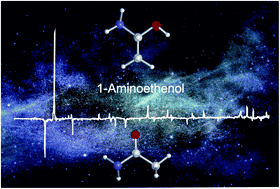
Interstellar Formation of Biorelevant Pyruvic Acid (CH3COCOOH)
Nils Fabian Kleimeier, André K. Eckhardt, Peter R. Schreiner and Ralf I. Kaiser
Chem 2020, xx,in press. DOI: 10.1016/j.chempr.2020.10.003
One of the key questions is how life could have emerged on early Earth and what chemicals and key reactions were involved. Terrestrial biomolecules, such as DNA, RNA, and peptides, formed from building blocks like nucleobases and amino acids. But where do these come from? Simple chemical building blocks could have formed on icy grains in space and may have survived comet impact on the early Earth. Pyruvic acid is widely accepted as a key prebiotic starting material, as it may have served as a fundamental building block for biorelevant molecules. This is underlined by the identification of pyruvic acid in carbonaceous meteorites. This study investigates the formation of pyruvic acid under interstellar conditions to encourage scientists in other fields to consider pyruvic acid as a potential interstellar molecule and include it in their radio-astronomical line searches. For chemists, the study will lead to a better understanding of the fundamental processes of abiotic syntheses of organic molecules.
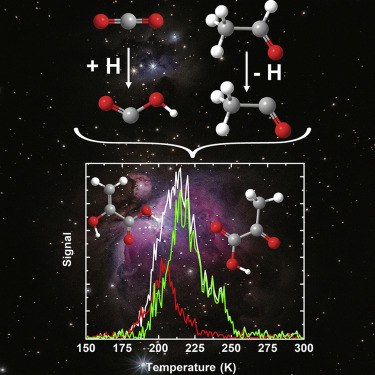
Spectroscopic Identification of the •SSNO Isomers
Lina Wang, Zhuang Wu, Bo Lu, André K. Eckhardt, Peter R. Schreiner, Tarek Trabelsi, Joseph S. Francisco, Qian Yao, Hua Guo and Xiaoqing Zeng
J. Chem. Phys. 2020, 153, 094303. DOI: 10.1063/5.0020669
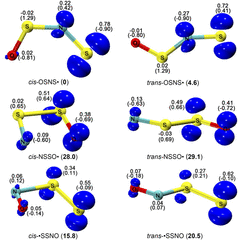 Elusive [S, S, N, O] isomers including the perthiyl radical •SSNO are S/N hybrid species in the complex bioinorganic chemistry of signaling molecules H2S and •NO. By mixing thermally generated disulfur (S2) with •NO in the gas phase, •SSNO was generated and subsequently isolated in cryogenic Ar- and N2-matrices at 10.0 K and 15.0 K, respectively. Upon irradiation with a 266 nm laser, •SSNO isomerizes to novel sulfinyl radicals cis-NSSO• and trans-NSSO• as well as thiyl radicals cis-OSNS• and trans-OSNS•, which have been characterized by combining matrix-isolation IR (15N-labeling) and UV/Vis spectroscopy and quantum chemical calculations at the CCSD(T)-F12/cc-pVTZ-F12 level of theory. The photo-induced reversible interconversion between NSSO• and OSNS• has also been observed.
Elusive [S, S, N, O] isomers including the perthiyl radical •SSNO are S/N hybrid species in the complex bioinorganic chemistry of signaling molecules H2S and •NO. By mixing thermally generated disulfur (S2) with •NO in the gas phase, •SSNO was generated and subsequently isolated in cryogenic Ar- and N2-matrices at 10.0 K and 15.0 K, respectively. Upon irradiation with a 266 nm laser, •SSNO isomerizes to novel sulfinyl radicals cis-NSSO• and trans-NSSO• as well as thiyl radicals cis-OSNS• and trans-OSNS•, which have been characterized by combining matrix-isolation IR (15N-labeling) and UV/Vis spectroscopy and quantum chemical calculations at the CCSD(T)-F12/cc-pVTZ-F12 level of theory. The photo-induced reversible interconversion between NSSO• and OSNS• has also been observed.Isolation and Characterization of the Free Phenylphosphinidene Chalcogenides C6H5P=O and C6H5P=S, the Phosphorous Analogues of Nitrosobenzene and Thionitrosobenzene
Artur Mardyukov, Felix Keul and Peter R. Schreiner
Angew. Chem. Int. Ed. 2020, 59, 12445–12449. DOI: 10.1002/anie.202004172
The structures and reactivities of organic phosphinidene chalcogenides have been mainly inferred from trapping or complexation experiments. Phosphinidene chalcogenide derivatives appear to be an elusive family of molecules that have been suggested as reactive intermediates in multiple organophosphorus reactions. The quest to isolate “free” phosphinidene chalcogenides remains a challenge in the field. Here, we present the synthesis, IR, and UV/Vis spectroscopic identification of hitherto elusive phenylphosphinidene oxide and phenylphosphinidene sulfide from the corresponding phosphonic diazide precursors. We isolated these higher congeners of nitroso‐ and thionitrosobenzene in argon matrices at 10 K. The spectral assignments are supported by B3LYP/6–311++G(3df,3pd) and MP2/cc‐pVTZ computations.

Photochemistry of HNSO2 in Cryogenic Matrices: Spectroscopic Identification of the Intermediates and Mechanism
Changyun Chen, Lina Wang, Xiaofang Zhao, Zhuang Wu, Bastian Bernhardt, André K. Eckhardt, Peter R. Schreiner, Xiaoqing Zeng
PCCP 2020, 22, 7975–7983. DOI: 10.1039/D0CP00962H
Small molecules solely consisting of H, N, O, and S are highly relevant intermediates in atmospheric chemistry and biology. Even though several isomers of [HNO2S] have been computationally predicted, only the IR spectra for the two lowest-energy isomers HNSO2 and syn–syn HONSO have been previously reported. Herein, the photochemistry (193 nm laser) of HNSO2 in N2-, Ne-, and Ar-matrices (≤15 K) has been studied. Aside from syn–syn HONSO, several new isomers including anti–syn HONSO, gauche–syn HOSNO, syn HOS(O)N, anti HOS(O)N, syn HS(O)NO, anti HN(O)SO, gauche–syn HSONO, and an elusive caged-radical pair HOS˙⋯˙NO have been identified. Additionally, the formation of fragments HONO, HO˙, ˙NO, and ˙NO2 has also been observed. The characterization of these species with matrix-isolation IR and UV/Vis spectroscopy is supported by 15N-labeling and quantum chemical computations at the B3LYP/6-311++G(3df,3pd) level. Furthermore, the photo-induced isomerization reactions, including the conformational conversion of syn–syn HONSO → anti–syn HONSO and reversible isomerization of HOSNO ↔ anti–syn HONSO, syn–syn HONSO ↔ HN(O)SO, HSONO ↔ HS(O)NO, and HOS˙⋯˙NO ↔ HOSNO have also been observed, and the underlying mechanism is discussed.
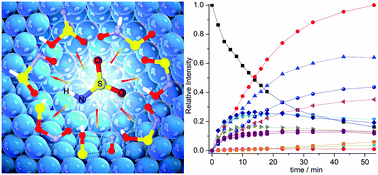
The Elusive Cyclotriphosphazene Molecule and its Dewar-Benzene Type Valence Isomer (P3N3)
Cheng Zhu, André K. Eckhardt, Alexandre Bergantini, Santosh K. Singh, Peter R. Schreiner, Ralf I. Kaiser
Sci. Adv. 2020, 6, eaba6934. DOI: 10.1126/sciadv.aba6934

Although the chemistry of phosphorus and nitrogen has fascinated chemists for more than 350 years, the Hückel aromatic cyclotriphosphazene (P3N3, 2) molecule—a key molecular building block in phosphorus chemistry—has remained elusive. Here, we report a facile, versatile pathway producing cyclotriphosphazene and its Dewar benzene–type isomer (P3N3, 5) in ammonia-phosphine ices at 5 K exposed to ionizing radiation. Both isomers were detected in the gas phase upon sublimation via photoionization reflectron time-of-flight mass spectrometry and discriminated via isomer-selective photochemistry. Our findings provide a fundamental framework to explore the preparation of inorganic, isovalent species of benzene (C6H6) by formally replacing the C─H moieties alternatingly through phosphorus and nitrogen atoms, thus advancing our perception of the chemical bonding of phosphorus systems.
Capture and reactivity of an elusive carbon-sulfur centered biradical
Dennis Gerbig, Bastian Bernhardt, Raffael C. Wende and Peter R. Schreiner
J. Phys. Chem. 2020, 124, 2014–2018. DOI: 10.1021/acs.jpca.9b11795
The initial oxidation product of dimethyl sulfide in the marine boundary layer, the methyl thiomethyl radical, has remained elusive. A structurally analogous biradical with one radical center in the α-position to a sulfur atom could now be obtained by UV irradiation of p-nitrobenzaldehyde dithiane isolated in solid dinitrogen (N2) or Ar at cryogenic temperatures. A spin-forbidden reaction with triplet dioxygen (3O2) does not occur. The dithiane of o-nitrobenzaldehyde rather undergoes a series of rearrangements under the same conditions, resulting in overall photodeprotection.

1,1-Ethenediol – The Long Elusive Enol of Acetic Acid
Artur Mardyukov, André K. Eckhardt, and Peter R. Schreiner
Angew. Chem. Int. Ed. 2020, 58, 5577–5580. DOI: 10.1002/anie.201915646
We present the first spectroscopic identification of hitherto unknown 1,1‐ethenediol, the enol tautomer of acetic acid. The title compound was generated in the gas phase through flash vacuum pyrolysis of malonic acid at 400 °C. The pyrolysis products were subsequently trapped in argon matrices at 10 K and characterized spectroscopically by means of IR and UV/Vis spectroscopy together with matching its spectral data with computations at the CCSD(T)/cc‐pCVTZ and B3LYP/6–311++G(2d,2p) levels of theory. Upon photolysis at λ=254 nm, the enol rearranges to acetic acid and ketene.

A silicon–carbonyl complex stable at room temperature
Chelladurai Ganesamoorthy, Juliane Schoening, Christoph Wölper, Lijuan Song, Peter R. Schreiner, and Stephan Schulz
Nat. Chem. 2020, 12, 608–614. DOI: 10.1038/s41557-020-0456-x
Highlights: a) Leigh Krietsch Boerner Chem. Eng. News. 2020, 98 (16), 9; b) David Schilter Nat. Rev. Chem. 2020, 4, 274; c) Nachr. Chem. 2020, 68, 42.
Main-group-element compounds with energetically high-lying donor and low-lying acceptor orbitals are able to mimic chemical bonding motifs and reactivity patterns known in transition metal chemistry, including small-molecule activation and catalytic reactions. Monovalent group 13 compounds and divalent group 14 compounds, particularly silylenes, have been shown to be excellent candidates for this purpose. However, one of the most common reactions of transition metal complexes, the direct reaction with carbon monoxide and formation of room-temperature isolable carbonyl complexes, is virtually unknown in main-group-element chemistry. Here, we show the synthesis, single-crystal X-ray structure, and density functional theory computations of a room-temperature-stable silylene carbonyl complex [L(Br)Ga]2Si:–CO (L = HC[C(Me)N(2,6-iPr2-C6H3)]2), which was obtained by direct carbonylation of the electron-rich silylene intermediate [L(Br)Ga]2Si:. Furthermore, [L(Br)Ga]2Si:–CO reacts with H2 and PBr3 with bond activation, whereas the reaction with cyclohexyl isocyanide proceeds with CO substitution.

Spectroscopic Identification of the Phenyltelluryl Radical and its Reactivity Toward Molecular Oxygen
Felix Keul, Artur Mardyukov and Peter R. Schreiner
PCCP 2019, 21, 25797–25801. DOI: 10.1039/C9CP05112K
The phenyltelluryl radical was prepared by high-vacuum flash pyrolysis of diphenyl ditelluride and was chacracterized by matrix isolation IR and UV/Vis spectroscopy. After doping the matrix with molecular oxygen and allowing bimolecular reactions, the hitherto unkown phenyltelluro peroxy radical formed and was identified via IR spectroscopy. Irradiation with light at λ = 436 nm leads to isomerization to the thermodynamically more stable novel phenyltelluroyl radical. All experimental findings agree well with density functional theory (UB3LYP/Def2QZVPP and UM06-2X/Def2QZVPP) computations.

Generation and Spectroscopic Identification of the Thiuram Radical (CH3)2NCS2∙
Artur Mardyukov, Felix Keul, and Peter R. Schreiner
J. Phys. Chem. A 2019, 123, 4937–4941. DOI: 10.1021/acs.jpca.9b03307
We report the first preparation, matrix-isolation, and IR and UV/vis spectroscopic characterization of the thiuram radical that is a highly important species for many industrial processes. The thiuram radical was prepared by thermal dissociation of tetramethylthiuram disulfide and was identified by matching its spectroscopic data with density functional theory [UB3LYP/6-311++G(3df,3pd)] computations. The title compound proved to be highly photolabile, and irradiation with light at λ = 623 nm affords a hitherto unknown carbamodithioic acid, N-(methyl)-N-methyl radical, as characterized by IR and UV/vis spectroscopy in low-temperature matrices.

Formation of Glyoxylic Acid (HCOCOOH) in Interstellar Ices – A Key Entry Point for Prebiotic Chemistry
André K. Eckhardt, Alexandre Bergantini, Santosh K. Sing, Peter R. Schreiner and Ralf I. Kaiser
Angew. Chem. Int. Ed. 2019, 58, 5663–5667. DOI: 10.1002/anie.201901059
With nearly 200 molecules detected in interstellar and circumstellar environments, the identification of the biologically relevant α‐keto carboxylic acid, glyoxylic acid (HCOCOOH), is still elusive. Herein, the formation of glyoxylic acid via cosmic‐ray driven, non‐equilibrium chemistry in polar interstellar ices of carbon monoxide (CO) and water (H2O) at 5 K via barrierless recombination of formyl (HCO) and hydroxycarbonyl radicals (HOCO) is reported. In temperature‐programmed desorption experiments, the subliming neutral molecules were selectively photoionized and identified based on the ionization energy and distinct mass‐to‐charge ratios in combination with isotopically labeled experiments exploiting reflectron time‐of‐flight mass spectrometry. These studies unravel a key reaction path to glyoxylic acid, an organic molecule formed in interstellar ices before subliming in star‐forming regions like SgrB2(N), thus providing a critical entry point to prebiotic organic synthesis.
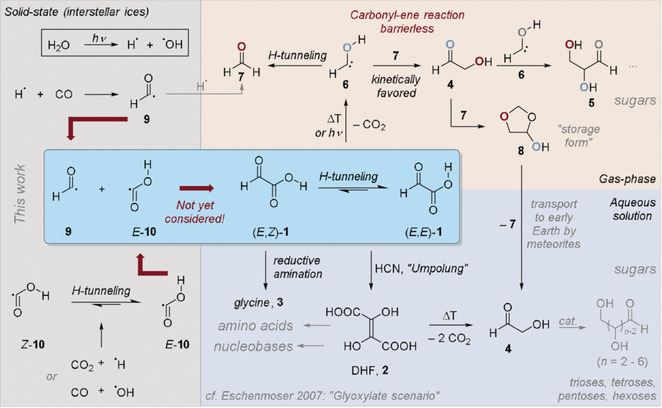
Caged Nitric Oxide-Thiyl Radical Pairs
Zhuang Wu, Changyun Chen, Jie Liu, Yan Lu, Jian Xu, Jian, Xiangya Liu, Ganglong Cui, Tarek Trabelsi, Joseph Francisco, Artur Mardyukov, André K. Eckhardt, Peter R. Schreiner, Xiaoqing Zeng
J. Am. Chem. Soc. 2019, 141, 3361–3365. DOI: 10.1021/jacs.8b12746

S-Nitrosothiols (RSNO) are exogenous and endogenous sources of nitric oxide in biological systems due to facile homolytic cleavage of the S–N bonds. By following the photolytic decomposition of prototypical RSNO (R = Me and Et) in Ne, Ar, and N2 matrixes (<10 K), elusive caged radical pairs consisting of nitric oxide (NO•) and thiyl radicals (RS•), bridged by O···S and H···N connections, were identified with IR and UV/vis spectroscopy. Upon red-light irradiation, both caged radical pairs (RS•···•ON) vanish and reform RSNO. According to the calculation at the CASPT2(10,8)/cc-pVDZ level (298.15 K), the dissociation energy of MeS•···•ON amounts to 4.7 kcal mol–1.
Control of excited state conformations of B,N-heterocycles
Zhenpin Lu, Julia Ruhl, Henrik Quanz, Georg Albrecht, Christian Logemann, Derck Schlettwein, Peter R. Schreiner and Hermann A. Wegner
Angew. Chem. Int. Ed. 2019, 58, 4259–4263. DOI: 10.1002/anie.201814104
We present a new concept to control the conformations of molecules in the excited state through harvesting negative hyperconjugation. The strategy was realized with the 2,3,1,4‐benzodiazadiborinane scaffold, which was prepared by a new synthetic procedure. Photochemical studies identified dual light emission, which was assigned to well‐defined conformers. The emission at longer wavelength can be switched off by restricting the rotational degrees of freedom in the solid state as well as by controlling the energy levels of the excited states through adjusting the solvent polarity.

Preparation and Characterization of Phenyl Phosphine Diselenide – The Monomeric Form of Woollins' Reagent
Artur Mardyukov, Felix Keul and Peter R. Schreiner
Eur. J. Org. Chem. 2019, 46, 387-390. DOI: 10.1002/ejoc.201800639
We report the preparation, matrix‐isolation, and IR and UV/Vis spectroscopic characterization of phenyl phosphine diselenide, thus providing the first experimental evidence of the monomeric form of Woollins' reagent. Phenyl phosphine diselenide was prepared by thermal dissociation of Woollins' reagent and was identified by matching its spectroscopic data with density functional theory [B3LYP‐D3/6‐311++G(3df,3pd)] computations. The title compound proved to be highly photolabile and irradiation with light at λ = 334 nm results in the formation of hitherto unknown phenyldiselenyl phosphirane. Upon λ = 465 nm irradiation it rearranges back to phenyl phosphine diselenide.

1,3-Dioxolane-4-ol Hemiacetal Stores Formaldehyde and Glycolaldhyde in the Gas Phase
André K. Eckhardt, Raffael C. Wende and Peter R. Schreiner
J. Am. Chem. Soc. 2018, 140,12333–12336. DOI: 10.1021/jacs.8b07480. Highlight: Cover picture of this issue.
We report the spontaneous gas-phase formation of 1,3-dioxolane-4-ol, a mixed hemiacetal resulting from the addition of glycolaldehyde to formaldehyde. It was spectroscopically characterized by matching matrix IR spectra with coupled cluster computations. The formation of the hemiacetal must be surface-catalyzed owing to the very high computed reaction barrier of 39.8 kcal mol–1. The reaction barrier is lowered by almost 20 kcal mol–1 when a single water molecule acts as a proton shuttle in a favorable six-membered transition state. We characterized the hemiacetal in solution via NMR spectroscopy and followed its decomposition into its constituents within a few hours; it also dissociates upon contact with water. Sugars form in the presence of Ca(OH)2, in line with formose-type reactivity. 1,3-Dioxolane-4-ol may be considered a storage form for formaldehyde and glycolaldehyde that is rather stable in the gas-phase.

Phenylsulfinyl Radical: Gas-Phase Generation, Photoisomerization and Oxidation
Jian Xu, Zhuang Wu, Huabin Wan, Guohai Deng, Bo Lu, André K. Eckhardt, Peter R. Schreiner, Tarek Trabelsi, Joseph S. Francisco and Xiaoqing Zeng
J. Am. Chem. Soc. 2018, 140, 9972–9978. DOI: 10.1021/jacs.8b05055

Arylsulfinyl radicals are key intermediates in sulfoxide chemistry. The parent molecule, phenylsulfinyl radical PhSO•, has been generated for the first time in the gas phase through high-vacuum flash pyrolysis of PhS(O)R (R = CF3 and Cl) at about 1000 K. Upon UV light irradiation (365 nm), PhSO• isomerizes to novel oxathiyl radical PhOS• in cryogenic matrices (2.8 K). Prolonged irradiation causes further isomerization of PhOS• to 2-hydroxyphenylthiyl radical, the formation of which has been also observed in the 193 nm laser photolysis of matrix-isolated 2-hydroxybenzenethiol. Concomitantly, ring-opening occurs during the UV photolysis of PhOS• and 2-hydroxybenzenethiol and forms an acyclic thioketoketene radical. Phenylsulfinyl radical reacts partially with molecular oxygen in the gas phase and yields phenyl radical Ph• and OSOO. Upon irradiation (365 nm), the isomeric oxathiyl radical also combines O2 with immediate dissociation to phenoxy radical PhO• and SO2. The identification of the intermediates with IR and UV–vis spectroscopy is supported by quantum chemical computations at the B3LYP/def2-TZVPP and UCCSD(T)/aug-cc-pV(D+d)Z levels of theory. The isomerization of PhSO• has been discussed based on the computed potential energy profile and the comparison with the intensively explored photochemistry of phenylperoxy radical PhOO•.
Making Glycine Methyl Ester Chiral
Dennis Gerbig, Sarina Desch and Peter R. Schreiner
Chem. Eur. J. 2018, 24, 11904-11907. DOI: 10.1002/chem.201802119
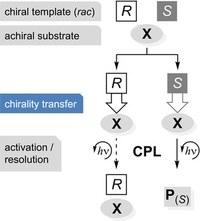
We demonstrate that the simple achiral amino acid glycine as its methyl ester inherits the chiral imprint of methyl lactate upon complexation, resulting in induced vibrational optical activity of the methylene C−H bonds. To mimic conditions of ice on comets that are considered long‐term reaction as well as storage entities for (organic) molecules, we employ the matrix isolation technique in conjunction with vibrational circular dichroism spectroscopy and DFT computations. The observed chirality transfer is likely a key element for the realization of concepts rationalizing chirogenesis, that is, the generation of a chiral imbalance.
Gas-phase sugar formation using hydroxymethylene as the reactive formaldehyde isomer.
André K. Eckhardt, Michael M. Linden, Raffael C. Wende, Bastian Bernhardt and Peter R. Schreiner
Nature Chem. 2018, 10, 1141–1147. DOI: 10.1038/s41557-018-0128-2
Carbohydrates (CH2O)n are the formal adducts of carbon (atoms) to water with a repeating unit that structurally resembles H–C̈–OH (hydroxymethylene). Although hydroxymethylene has been suggested as a building block for sugar formation, it is a reactive species that had escaped detection until recently. Here we demonstrate that formaldehyde reacts with its isomer hydroxymethylene to give glycolaldehyde in a nearly barrierless reaction. This carbonyl–ene-type transformation operates in the absence of base and solvent at cryogenic temperatures similar to those found in extraterrestrial environments or interstellar clouds. Hydroxymethylene acts as a building block for an iterative sugar synthesis, as we demonstrate through the formation of the triose glyceraldehyde. The thermodynamically preferred ketose dihydroxyacetone does not form, and the formation of further branched sugars in the iterative synthesis presented here is unlikely. The results therefore provide a link between the well-known formose (Butlerow) reaction and sugar formation under non-aqueous conditions.

The Near-UV Absorber OSSO and its Isomers
Zhuang Wu, Huabin Wan, Jian Xu, Bo Lu, André K. Eckhardt, Peter R. Schreiner, Changjian Xie, Hua Guo and Xiaoqing Zeng
Chem. Commun. 2018, 54, 4517–4520. DOI: 10.1039/C8CC00999F
Highlight: Venusian near-UV absorber mystery solved in Chemistry World 2018, March 09, 2018.
Disulfur dioxide, OSSO, has been proposed as the enigmatic “near-UV absorber” in the yellowish atmosphere of Venus. However, the fundamentally important spectroscopic properties and photochemistry of OSSO are scarcely documented. By either condensing gaseous SO or 266 laser photolysis of an S2⋯O2 complex in Ar or N2 at 15 K, syn-OSSO, anti-OSSO, and cyclic OS(![[double bond, length as m-dash]](http://www.rsc.org/images/entities/char_e001.gif) O)S were identified by IR and UV/Vis spectroscopy for the first time. The observed absorptions (λmax) for OSSO at 517 and 390 nm coincide with the near-UV absorption (320–400 nm) found in the Venus clouds by photometric measurements with the Pioneer Venus orbiter. Subsequent UV light irradiation (365 nm) depletes syn-OSSO and anti-OSSO and yields a fourth isomer, syn-OSOS, with concomitant dissociation into SO2 and elemental sulfur.
O)S were identified by IR and UV/Vis spectroscopy for the first time. The observed absorptions (λmax) for OSSO at 517 and 390 nm coincide with the near-UV absorption (320–400 nm) found in the Venus clouds by photometric measurements with the Pioneer Venus orbiter. Subsequent UV light irradiation (365 nm) depletes syn-OSSO and anti-OSSO and yields a fourth isomer, syn-OSOS, with concomitant dissociation into SO2 and elemental sulfur.

